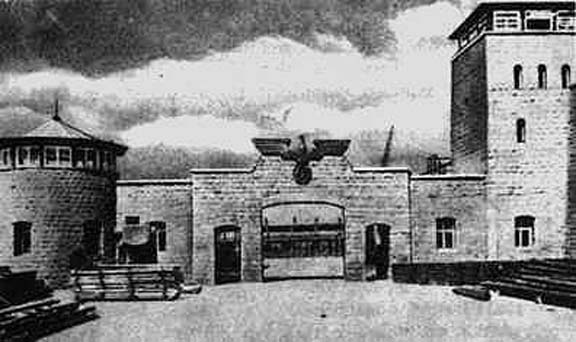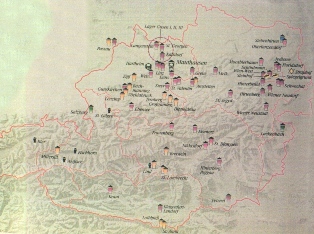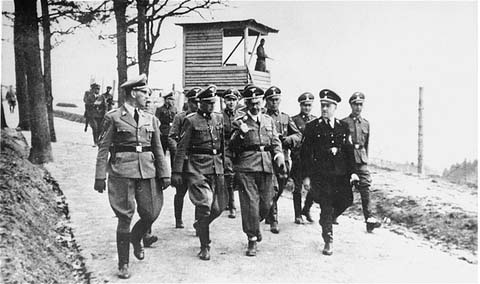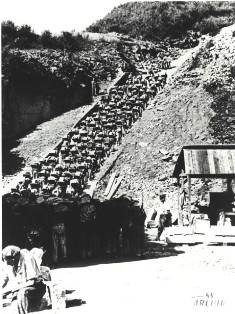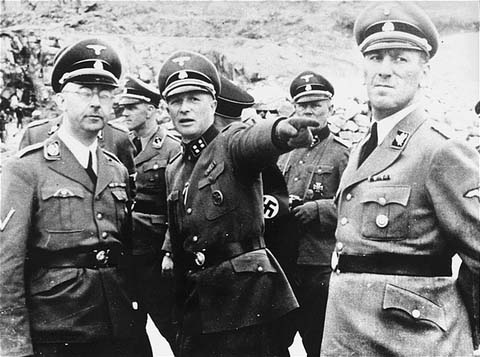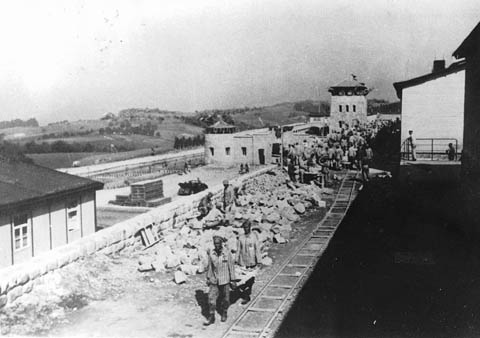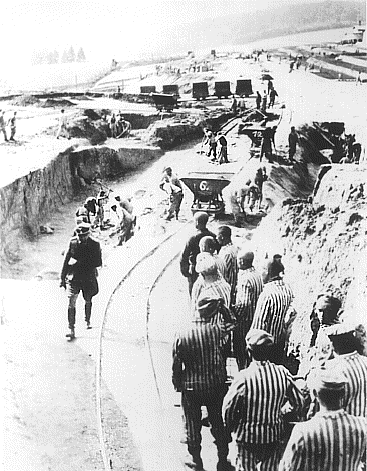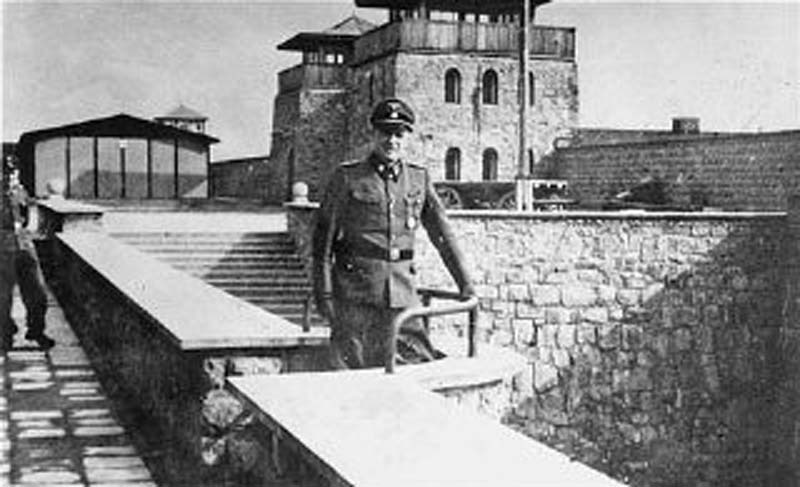Holocaust Education & Archive Research Team
|
|
Other Camps
Key Nazi personalities in the Camp System The Labor & Extermination Camps
Auschwitz/Birkenau Jasenovac Klooga Majdanek Plaszow The Labor Camps
Trawniki
Concentration Camps
Transit Camps |
|||||||
Mauthausen Concentration Camp
Mauthausen concentration was camp created shortly after the Anschluss of Austria in March 1938 near an abandoned stone quarry about three miles from the town of Mauthausen in Upper Austria. On 16 May 1938 work began in the quarry, initially employing thirty civilian workers. The first prisoners were brought to the camp on 8 August 1938 and were put to work in the construction of the camp and at the quarry.
Most of the prisoners brought to Mauthausen in the first year of its existence were criminal offenders and the rest were “asocial elements.” Almost all were transferred from Dachau. The first consignment was accompanied by 88 SS guards from the Dachau Totenkopfverbade.
In 1938 a total of 1100 prisoners arrived. The first political prisoners, also from Dachau arrived in May 1939 and soon afterwards groups of political prisoners were brought from jails in Czechoslovakia. Late in September the Dachau “Punishment Squad” arrived at the camp.
In December 1939 there were 2,666 prisoners almost all Germans interned in Mauthausen. During the course of 1940 about 11,000 new prisoners were recorded in the camps “book of numbers,” which served to record each new prisoner, together with their camp number.
The minority were German prisoners from the camp of Sachsenhausen 1032 and Buchenwald 300 who were all transferred to the first sub-camp of the main camp- Gusen. A further three consignments brought an unknown number of Spanish republicans who had fled from Franco’s regime and been caught in France after its defeat by Germany. The number of prisoners in 1940 reached 3833.
Seven consignments of Spanish prisoners arrived in 1941 and their number in the camp reached 7241. Many Jews were also sent together with groups of Czech prisoners. On 12 May 1940 the first Jews from the Netherlands arrived, and on 20 October 1941 an initial 4205 Soviet Prisoners –of – War, of whom about 2,000 were transferred to Gusen.
During 1941 Mauthausen received a total of 18,000 new prisoners. The mortality rate was high and the number of prisoners in Mauthausen and Gusen reached only 11,135. In 1942 in addition to Czech, Dutch, Soviet and Yugoslav prisoners, internees also arrived from France, Belgium, Greece and Luxembourg.
A new category of prisoners those in protective custody were transferred from various prisoners. A despatch of 218 such prisoners reached Mauthausen on 26 November from the Regensburg jail. Altogether 13,000 new prisoners came to the camp in 1942.
On 19 August Reinhard Heydrich published an edict that divided the concentration camps into categories. Only Mauthausen and Gusen were placed in the harshest classification. The stream of prisoners of different nationalities continued throughout 1943, during which 21,028 new prisoners were recorded of whom only a few were Jews.
That year 8,334 prisoners were entered in the records as having died at Mauthausen and Gusen along with 147 Prisoners – of – War. In addition many victims were killed by order of the Gestapo immediately upon their arrival at the camp and did not go through the registration procedures.
In 1944 the number of prisoners reaching Mauthausen increased considerably – many sub-camps were built and the new prisoners were sent to them. A record 65,645 new prisoners were listed in the “book of numbers.” The maximum prisoner population at any one time in 1944 was 114,524.
Beginning in May 1944 the camp received large transports of Jews from Auschwitz in May and June 1944 four such transports brought a total of 7500 prisoners.
On 10 August 1944 a transport of 4589 Jewish prisoners came from the Plaszow Labour camp near Krakow. The last large transport in 1944 arrived in late September bringing 6449 prisoners of whom half were Jews. According to the camp records a total of 13,322 Jewish males and 504 Jewish females entered Mauthausen in 1944. The number of Jews who died that year was 3437.
On 9 September 1944 a group of thirty-nine Dutchmen, one American, and seven Englishmen, all of them active, in the anti-Nazi underground, were brought to Mauthausen.
After spending the night inside the bunker they were driven, barefoot and in their underclothes, to the quarry, where the 186 steps were lined on both sides by SS and Kapos swinging their cudgels and anticipating a spectacle.
The forty-seven prisoners were loaded with stone slabs of up to sixty pounds in weight, and then forced to run up the steps. The run was repeated again and again, and the blows fell faster and faster as the exhausted prisoners stumbled on the uneven steps. One of the prisoners was a British Jew, Marcus Bloom, who had operated a clandestine radio in Nazi- occupied Europe. He was the first to fall, he was shot in the head at point – blank range.
On 25 January 1945 the first transport of Auschwitz evacuees reached Mauthausen. In one week 9,000 prisoners of various nationalities arrived, the majority of them Jews.
One of the deportees from Auschwitz, Yehuda Bakon later recalled how on the march, “The children said – it is good that our parents were killed in the gas –chambers. They did not have to undergo all this torturing and suffering – because we saw they shot everyone who fell.”
In April 1945 another gigantic flow of Jewish prisoners, who had been transferred from their native Hungary to camps along the Austrian – Hungarian border reached Mauthhausen.
A total of 24,793 new prisoners were recorded in the camps books for 1945. The number of the last prisoner 139,157 was allocated on 3 May 1945 – two days before the camps liberation.
The camp area was divided into 3 sections
The prison camp occupied the main part of the camp area and had 3 sectors.
Each hut was designed to hold 300 prisoners, but in most instances double that number and even more were packed into them. Opposite the main gate was the assembly ground, where the prisoners had to stand for the morning and evening roll-call and where certain prisoners were taken to be killed in the presence of all others.
On one side of the parade ground were three stone buildings. Two were used for the camp services – kitchens, showers, and laundry. The third housed the prison bunker and the gas chamber disguised as a shower. Beneath the bunker was the crematorium – in a nearby cell prisoners were shot. Outside the camp enclosure was the “Russian Camp” which was converted into the camp hospital in the spring of 1943.
About a month before the liberation, in April 1945 a tent camp was set up outside the camp enclosure, with 14 large tents. It was designated for Hungarian Jews who had been brought from camps along the Austrian- Hungarian border and for Jews from the entire network of Mauthausen’s camps to stay in until they were taken to Gunskirchen. The entire Mauthausen camp covered about 37 acres.
The first commandant of the Mauthausen camp was SS- Standartenfuhrer Albert Sauer. In August 1939 he was replaced by SS- Standartenfuhrer Franz Ziereis, who retained this post until the end of the war. There were seven SS Officers and heads of divisions that served under him.
Ziereis deputy and the Commandant of the prison camp was SS- Hauptsturmfuhrer Georg Bachmayer, who had two deputies. Beneath them were the Rapportfuhrer the recording officer, the labour service officer and the officer responsible for roll-calls and general administration work as well as block officers and labour gang officers.
On 3 September 1944 there were 91 SS- Blockfuhrers and Kommandofuhrers in Mauthausen. The camps Political Department was headed by SS- Hauptsturmfuhrer Karl Schulz who was in command of 19 NCO’s and many more prisoners. The camp guard units belonged to the Mauthausen SS – Totenkopfverbande.
Most of the prisoners in Mauthausen holding supervisory and other posts were criminal offenders, and the camp authorities encouraged them to treat the rank and file prisoners harshly. They had complete control over the lives of the prisoners under their command.
The principal positions held by prisoners were those of Camp Elder, and his deputies and camp registrar. The work in the camp was supervised by the Kapo’s and the blocks were under the authority of the block elder, the block registrar and the room elder. All enjoyed a large number of privileges.
The Poles were the largest national group at Mauthausen, the first Polish prisoners arrived on 9 March 1940 and during the same year another 9 transports arrived.
The Polish students and members of the underground in the first transports were killed in the autumn of 1940. The camps record of the dead lists 30,203 Poles, including many Polish Jews. Altogether there were nearly 50,000 Poles in the Mauthausen camps complex.
Until the spring of 1941 only a few Jews arrived at Mauthausen – most died within a short time from the work at the quarry and from maltreatment. Beginning in 1941, groups of Jews began arriving.
The first consisted of Czech Jews who were brought with the transports of Czech political prisoners. The SS officers, the Kapos, and the block elders treated this group of Jews harshly, and all soon perished.
After the assassination in Prague of Reinhard Heydrich by the Czech underground on 27 May 1942 , two hundred and fifty-three Czechs were brought to Mauthausen and killed. The women among them were taken in groups to the gas chamber. Most of the Czech prisoners were murdered were murdered in the three months, following Heydrich’s assassination.
On 19 February 1941 a German patrol in Amsterdam entered a tavern run by a Jewish refugee from Germany, Ernst Cahn. In the tavern, a protective device which Cahn had installed, an ammonia flash, went off by accident, spaying the Germans with ammonia.
Cahn was at once arrested, and three days later, as a reprisal for his act of “resistance” , the SS raided the Jewish quarter of Amsterdam, seized 425 Jews, most of them young men, subjected them to beatings and abuse and then on 27 February 1941 deported 389 of them to Buchenwald and after two months 361 of them were deported to Mauthausen.
To protest against the raids against the Jews in Amsterdam Dutch workers organised a strike on 25 February 1941, in Amsterdam, Zaandam, Hilversum, Utrecht and Rotterdam followed their example.
At Mauthausen the Dutch Jews were all put to work in the stone quarries, hauling massive blocks of stone up the steep incline. As they climbed the 186 steps, they were whipped and beaten.
On the third day after the arrival of the Dutch Jews the camp guards began machine-gunning the climbers on the steps. On the fourth day, some ten young Jews linked hands and jumped to their deaths. The Germans referred to those who had jumped as “parachutists.”
In order to prevent a recurrence of this collective suicide, the remaining prisoners were placed under the charge of two particularly sadistic guards, one known as “the blonde fraulein”, the other as “Hans the killer.” By the autumn, there were no survivors.
From mid-1944 on, far larger groups of Jews began to arrive. The six thousand Hungarian Jews brought to work in the Mauthausen camps after Selektionen at Auschwitz in May and June 1944 were followed by forty-six hundred Jews from the Plaszow labour camp.
The planning for the deportations of Jews from Hungary, was carried out by Adolf Eichmann and his key subordinated at Mauthausen, of all places, on 10 March 1944. These Jews too were treated far more harshly than the other prisoners, being employed in digging tunnels for the munitions factories. The work was conducted in three shifts, at an extremely accelerated pace.
No effort was made to spare the labour force, after a month or two they were broken men who could hardly put one foot before the other. Each month thousands of new prisoners arrived to replace those who had died.
The Jews subsisted in conditions far worse than those of other groups. Starvation and diseases caused by starvation accounted for more than 95 percent of the deaths. From 25 January 1945 with the general evacuation of Auschwitz, a second wave of transports began to arrive at Mauthausen. The majority of the nine thousand new prisoners were Jews.
Like their predecessors, they were sent to work principally in digging underground tunnels at various sub-camps. The last large group consisted of Hungarian Jews. Beginning in the autumn of 1944, tens of thousands of Hungarian Jews had been sent to build a line of fortifications along the border between Austria and Hungary.
As the front drew near in March and April of 1945, the camps there were evacuated and the prisoners sent by foot to Mauthausen – many died during these evacuations. They were then housed in a tent camp, where they slept on the muddy earth in greatly overcrowded conditions, with no sanitation, no running water, and no toilets.- they had to relieve themselves in pits that they dug.
Food was supplied in small quantities – mass epidemics of typhus and dysentery soon broke out, causing many deaths. On 9 April when there were already more than 8,500 prisoners in the tent camp, the transfer to this camp of all the Jewish prisoners in the main camp and at Gusen commenced.
An estimated 3,000 prisoners died in the tent camp. On 16 April the first group of prisoners was taken from there to the Gunskirchen camp about 37 miles west of Mauthausen. The rest of the prisoners were transferred to Gunskirchen in two groups, a few days apart. They were taken by forced march, and all who fell by the way were shot on the spot.
In the second half of 1944, the stream of prisoners brought to Mauthausen increased. The mortality rate rose to maximal dimensions. According to the official camp records, 24,613 prisoners died between January and May.
The actual number of dead was far greater however, since the frequent transfers made exact record keeping impossible. Transports arrived from the camps that had been evacuated – Gross Rosen, Bergen –Belsen, Orainienburg, Dora-Mittlebau, Neuengamme, Buchenwald, Ravensbruck, Sachsenhausen and other small camps.
In late March and in April 1945 the prisoners from the satellite camps were marched to the main camp. All those who could not march were killed with phenol injections, and their bodies were buried in the camps.
The main camp was now full to overflowing and in total disorder. The severe over-crowding and reduced food rations hastened the death of many. In the hospital, cases of cannibalism were documented. The crematoria could not burn all the corpses, and a gigantic grave was dug near the camp enclosure for the concealment of ten thousand corpses.
At the same time, in April 1945, the Germans began to burn documents and to release favoured prisoners, particularly criminal offenders, inmates of long standing, and those holding posts in the camp.
Prisoners of Norwegian, Danish, Dutch, Belgian, and French nationality were released and handed over to the International Red Cross which took them to Switzerland. The Jews were all transferred to Gunskirchen under the most severe conditions, an act interpreted by the prisoners as a step toward their slaughter.
On 3 May 1945 the guarding of the camp was handed over to a police unit from Vienna, on the following day work ceased and the SS officers left the camp. That same day the officer in charge of the Bunker killed all the prisoners employed in the crematorium and in the Bunker, with a single exception.
The next day at 11:30 in the morning American army tanks entered Mauthausen – the prisoners opened the gates and the camp was liberated. The number of prisoners who passed through Mauthausen is estimated at 199,404. It is believed that 119,000 of them died, of whom 38,120 were Jews.
This number includes the victims at the Hartheim castle euthanasia centre. From August 1941 to October 1942 and from April 1944 to the end of that year, sick and debilitated prisoners and “undesirable” prisoners, including Jews, were regularly sent from the network of Mauthausen camps to the Hartheim castle near Linz, to be killed in the gas chamber there.
The suffering of the Mauthausen internees has been expressed in the Greek composer Mikis Theodorakis’s Ballard of Mauthausen, based on a work by the Greek Jewish poet Jacob Kambanelis.
One of Mauthausen’s most famous prisoners was Simon Wiesenthal recalled the liberation; weighing only 110 pounds laying in Hut B of the so-called death block, where those unfit to work were left to die. On the morning of 5 May 1945 he staggered outside – “I don’t know how I managed to get up and walk” – to meet the first American tank.
Sources:
Encyclopedia of the Holocaust - Israel Gutman (Ed) - New York 1990 The Holocaust by Sir Martin Gilbert, published by Colins, London 1986 The Yellow Star by Gerhard Schoenberner, published by Corgi Books 1969 Justice not Vengeance by Simon Wiesenthal , published by Weidenfeld and Nicolson London 1989. NARA DHM, Berlin
Copyright Chris Webb H.E.A.R.T 2007
|
